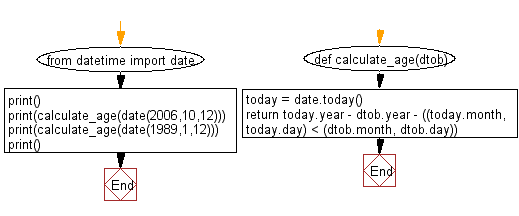An easy way to get a datetime object is to use datetime.now. Import datetime datetime.datetime.now datetime.datetime(2016, 11, 15, 9, 59, 25, 608206) As you can see, the now method returned a datetime object that represents the point in time when now was called. Kite is a free autocomplete for Python developers. Code faster with the Kite plugin for your code editor, featuring Line-of-Code Completions and cloudless processing. Here we are using datetime.date class which is used to represent calendar date values. Today method is used to fetch current date. Datetime.date.today Output datetime.date (2019, 7, 19) In order to display it like a proper calendar date, we can wrap it within print command. Print (datetime.date.today ) Output 2019-07-19. To get current UTC time in Python, we can use datetime module. In 5: import datetime In 6: datetime. Utc) Out 6: datetime. Datetime (2014, 11, 22, 14, 42, 21, 34435, tzinfo = datetime. Utc) Unix time / POSIX time / Epoch time: It is a system for describing instants in time, defined as the.
Question or problem about Python programming:
I have a python datetime instance that was created using datetime.utcnow() and persisted in database.
For display, I would like to convert the datetime instance retrieved from the database to local datetime using the default local timezone (i.e., as if the datetime was created using datetime.now()).
How can I convert the UTC datetime to a local datetime using only python standard library (e.g., no pytz dependency)?
It seems one solution would be to use datetime.astimezone( tz ), but how would you get the default local timezone?
How to solve the problem:
Solution 1:

In Python 3.3+:
In Python 2/3:
Using pytz (both Python 2/3):

Python 3.3
Python 2
pytz
Note: it takes into account DST and the recent change of utc offset for MSK timezone.
I don't know whether non-pytz solutions work on Windows.
Solution 2:
You can't do it with only the standard library as the standard library doesn't have any timezones. You need pytz or dateutil.
Or well, you can do it without pytz or dateutil by implementing your own timezones. But that would be silly.
Solution 3:
You can't do it with standard library. Using pytz module you can convert any naive/aware datetime object to any other time zone. Lets see some examples using Python 3.
Naive objects created through class method utcnow()
To convert a naive object to any other time zone, first you have to convert it into aware datetime object. You can use the replace method for converting a naive datetime object to an aware datetime object. Then to convert an aware datetime object to any other timezone you can use astimezone method.
The variable pytz.all_timezones gives you the list of all available time zones in pytz module.
Naive objects created through class method now()
Because now method returns current date and time, so you have to make the datetime object timezone aware first. The localize function converts a naive datetime object into a timezone-aware datetime object. Then you can use the astimezone method to convert it into another timezone.
Solution 4:
Building on Alexei's comment. This should work for DST too.
Solution 5:
I think I figured it out: computes number of seconds since epoch, then converts to a local timzeone using time.localtime, and then converts the time struct back into a datetime…
It applies the summer/winter DST correctly: Space saving bedroom drawers.

In Python 3.3+:
In Python 2/3:
Using pytz (both Python 2/3):
Python 3.3
Python 2
pytz
Note: it takes into account DST and the recent change of utc offset for MSK timezone.
I don't know whether non-pytz solutions work on Windows.
Solution 2:
You can't do it with only the standard library as the standard library doesn't have any timezones. You need pytz or dateutil.
Or well, you can do it without pytz or dateutil by implementing your own timezones. But that would be silly.
Solution 3:
You can't do it with standard library. Using pytz module you can convert any naive/aware datetime object to any other time zone. Lets see some examples using Python 3.
Naive objects created through class method utcnow()
To convert a naive object to any other time zone, first you have to convert it into aware datetime object. You can use the replace method for converting a naive datetime object to an aware datetime object. Then to convert an aware datetime object to any other timezone you can use astimezone method.
The variable pytz.all_timezones gives you the list of all available time zones in pytz module.
Naive objects created through class method now()
Because now method returns current date and time, so you have to make the datetime object timezone aware first. The localize function converts a naive datetime object into a timezone-aware datetime object. Then you can use the astimezone method to convert it into another timezone.
Solution 4:
Building on Alexei's comment. This should work for DST too.
Solution 5:
I think I figured it out: computes number of seconds since epoch, then converts to a local timzeone using time.localtime, and then converts the time struct back into a datetime…
It applies the summer/winter DST correctly: Space saving bedroom drawers.
Hope this helps!
- Related Questions & Answers
- Selected Reading
To manipulate dates and times in the python there is a module called datetime. There are two types of date and time objects. The types are naïve and the aware.
In the naïve object, there is no enough information to unambiguously locate this object from other date-time objects. In this approach it uses Coordinate Universal Time (UTC).
In the aware type objects there are different information regarding algorithmic and political time adjustments. This type of objects is used to represent some specific time moments.
To use this module, we should import it using −
There are different classes, constants and methods in this module.
The constants are −
| Sr.No. | Constant & Description |
|---|---|
| 1 | datetime.MINYEAR It is the smallest Year number, which can be applied as date or datetime objects. The value is 0 |
| 2 | datetime.MAXYEAR It is the largest Year number, which can be applied as date or datetime objects. The value is 9999 |
The Available datatypes are −
| Sr.No. | Datatypes & Description |
|---|---|
| 1 | date It is date type object. It uses Gregorian calendar. It has year, month, day attributes. |
| 2 | time It is a time object class. It is independent of any particular day. It has hour, minute, second, microsecond and tzinfo attributes. |
| 3 | datetime It is a combined set of dates and times. |
| 4 | timedelta It is used to express the difference between two date, time or datetime values in milliseconds. |
| 5 | tzinfo It is an Abstract Base Class. It holds the time zone information. It is used by the datetime and time classes. |
| 6 | timezone In this class, it implements tzinfo. There is a fixed offset from the UTC |
Date Type Object
The date objects represent a date. In the date there are Day, month and the Year part. It uses the Gregorian Calendar. According to this calendar the day of January 1 of Year 1 is called as the day number 1, and so on.
Some date related methods are −
Method date.date(year, month, day)
This is the constructor to create a date type object. To create a date, all arguments are required as integer type data. The year must be in range MINYEAR & MAXYEAR. If the given date is not valid, it will raise ValueError.
Method date.today()
This method is used to return the current local date.
Method date.fromtimestamp(timestamp)
This method is used to get the date from POSIX timestamp. If the timestamp value is out of range, it will raise OverflowError.
Method date.fromordinal(ordinal)
This method is used to get the date from proleptic Gregorian Calendar ordinal. It is used to get the date from the date count from January 1 of Year 1.
Method date.toordinal()
This method is used to return a date to proleptic Gregorian Calendar ordinal.
Method date.weekday()
This method is used to return the date of a week as an integer from the date. The Monday is 0, Tuesday is 1 and so on.
Method date.isoformat()
This method is used to return the date as an ISO 8601 format string. The format is YYYY-MM-DD.
Example Code
Output
Time Object
The time object represents a local time. In the time there are hour, minute second, microsecond, tzinfo part. The hour will be in range 0 to 24 and the minute and second will be in range 0 to 60, and microseconds will be in range 0 to 1000000.
Some time related methods are
Method time.fromisoformat(time_string)
This method is used to get time from an ISO 8601 string. It can take any of the output of time.isoformat() method.
Method time.replace(hour = self.hour, minute = self.minute, second = self.second, microsecond = self.microseconds, tzinfo = self.tzinfo, *fold=0)
This method is used to return a time by taking values from the arguments. If no argument is passed, it will return the same time object values.
Python Date Example
Method time.tzname()
This method is used to return the name of the time zone. If the tzinfo is None, it will return None.
Datetime Object
The datetime object holds both date and time. As date object, it supports Gregorian Calendar and as Time object it holds exactly 3600*24 seconds for each day.
It supports all date and time related methods, some methods are also present for datetime. These are like −
Method datetime.now(tz=None)
This method is used to get the current date and time. If the tz is not present or None, then, it will return date like the today() method.
Method datetime.utcnow()
This method is used to get the current UTC date and time related information.
There are another two methods called strftime() and strptime(). These methods are applicable for both date and time objects, as well as datetime objects.
Method datetime.strftime(format[, t])
The method strftime() converts a tuple or struct_time representing a time as returned by gmtime() or localtime() to a string as specified by the format argument. If t is not provided, the current time as returned by localtime() is used. format must be a string. An exception ValueError is raised if any field in t is outside of the allowed range.
Method datetime.strftime(format[, t])
The method strptime() parses a string representing a time according to a format. The return value is a struct_time as returned by gmtime() or localtime(). The format parameter uses the same directives as those used by strftime(); it defaults to '%a %b %d %H:%M:%S %Y' which matches the formatting returned by ctime().
These two methods use some directives. Some of them are listed below −
| Sr.No. | Directives & Description |
|---|---|
| 1 | %A Full Weekday name |
| 2 | %B Full Month Name |
| 3 | %d Day of the month (0 to 31) |
| 4 | %S Second Xampp php 7.2. |
| 5 | %G 4 digit Year, corresponding to ISO week number |
| 6 | %m Month (1 to 12) |
| 7 | %M Minute |
| 8 | %T Current time, equal to %H:%M:%S |
| 9 | %W Week number of the current year, starting with the first Monday as the first day of the first week |
| 10 | %w Day of the week as a decimal, Sunday=0 |
| 11 | %Y Year including the century |
| 12 | %Z or %z Time zone or name or abbreviation |

